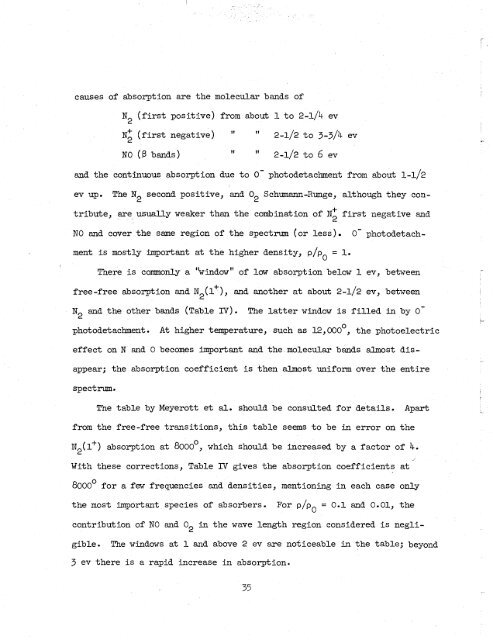Theory of the Fireball
Theory of the Fireball
Theory of the Fireball
You also want an ePaper? Increase the reach of your titles
YUMPU automatically turns print PDFs into web optimized ePapers that Google loves.
causes <strong>of</strong> absorption are <strong>the</strong> molecular bands <strong>of</strong><br />
N (first positive) from about 1 to 2-1/4 ev<br />
2<br />
N: (first negative) " 2-1/2 to 3-3/4 ev<br />
NO (e bands)<br />
11<br />
" 2-1/2 to 6 ev<br />
and <strong>the</strong> continuous absorption due to 0- photodetachment from about 1-1/2<br />
ev up. The N2 second positive, and 0 Schumann-Runge, although <strong>the</strong>y con-<br />
2<br />
tribute, are . .<br />
usually weaker than <strong>the</strong> combination <strong>of</strong> N+ first negative and<br />
2<br />
NO and cover <strong>the</strong> same region <strong>of</strong> <strong>the</strong> spectrum (or less) 0- photodetach-<br />
ment is mostly important at <strong>the</strong> higher density, p/p = 1.<br />
0<br />
There is comonly a %Window" <strong>of</strong> low absorption below 1 ev, between<br />
free-free absorption and N2(lf), and ano<strong>the</strong>r at about 2-1/2 ev, between<br />
N2 and <strong>the</strong> o<strong>the</strong>r bands (Table IV) . The latter window is filled in by 0-<br />
photodetachment. At higher temperature, such as 12,000°, <strong>the</strong> photoelectric<br />
effect on N and 0 becomes important and <strong>the</strong>.molecular bands almost dis-<br />
appear; <strong>the</strong> absorption coefficient is <strong>the</strong>n almost uniform over <strong>the</strong> entire<br />
spectrum.<br />
The table by Meyerott et al. should be consulted for details. Apart<br />
from <strong>the</strong> free-free transitions, this table seems to be in error on <strong>the</strong><br />
N2( 1') absorption at 8000°, which should be increased by a factor <strong>of</strong> 4.<br />
With <strong>the</strong>se corrections, Table IV gives <strong>the</strong> absorption coefficients at<br />
8000' for a few frequencies and densities, mentioning in each case only<br />
<strong>the</strong> most important species <strong>of</strong> absorbers. For p/po = 0.1 and 0.01, <strong>the</strong><br />
contribution <strong>of</strong> NO and O2 in <strong>the</strong> wave length region considered is negli-<br />
gible. The windows at 1 and above 2 ev are noticeable in <strong>the</strong> table; beyond<br />
3 ev <strong>the</strong>re is a rapid increase in absorption.<br />
35<br />
J<br />
L. -~
















